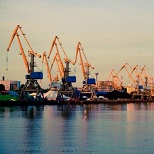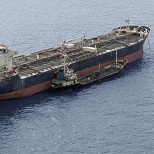Occupation of the territory of Ukraine in focus of maritime law
History of the modern public international maritime law goes back to the 1st UN Conference on the Law of the Sea held on April 24 – 29, 1958, in Geneva. The new stage in development of international maritime law was the 3rd UN Conference on the Law of the Sea which resulted in adoption of the UN Convention on the Law of the Sea dd. the 10th of December 1982 (UNCLOS) which entered into force on the 16th of November 1994. This Convention is called the Constitution of Seas for good reason, since it displays the long-term experience of progressive development of international maritime law.
The following question arises: how much is the modern international law fair and effective? Probably it is an issue of the future. Maybe we still have not reached such model of law providing prompt punishment and undelayed justification. But most states include in their agenda the issue of reviewing the basic principles of international law. In fact, the modern international law proved to be not effective enough, as shown by the current political crisis in Ukraine. There are growing violations of states’ sovereign rights over a territory and water area, particularly but not exceptionally.
A challenge of the Russian Federation to the generally accepted code of conduct is especially cynic and blatant. No doubt, it is a challenge to the whole international global community. The largest threat of this challenge is aimed at Ukraine. Unfortunately, we shall state that such severe confrontation, which turned quickly to the military conflict, was caused by the former strategic partner of Ukraine.
General characteristic of the military and political crisis in Ukraine
On the 19th of March 2014 President of the Russian Federation introduced to the State Duma the Law on annexation of the Crimea and Sevastopol. On the next day the Russian Parliament adopted in three readings the Federal Constitutional Law on inclusion of the Ukrainian region into Russia. Then the following laws were adopted by the Council of Federation and signed by Vladimir Putin, President of the Russian Federation: the Ratification of Treaty on annexation of the Crimea and Sevastopol Act, the Act on procedure of inclusion of the Ukrainian regions into Russia and on transition period of their integration.
On the 27th of March the UN General Assembly made a resolution upon Ukraine which invoked states, international organizations and other institutions not to recognize any changes in status of the Crimea and Sevastopol and to restrain from any actions which may be interpreted as recognition of any changes in their status.
In April 2014 a military conflict escalated at the territory of Donetsk and Lugansk Region.
On the 11th of May a poll took place in some cities of these regions, called by organizers “The Referendum on state sovereignty of the Donetsk People’s Republic” and “The Referendum on state sovereignty of the Lugansk People’s Republic” accordingly.
While the territory of Sevastopol and the Autonomous Republic of the Crimea, no doubt, is treated as the territory of Ukraine occupied and annexed by the Russian Federation, it is more difficult to determine the fact of occupation in certain districts of Donetsk and Lugansk Regions being out of control of the state power of Ukraine.
But of course it is possible, as shown by practice of the European Court of Human Rights (ECHR). A bright example is the ECHR decision upon the case Ila?cu and Others vs. Moldova and Russia where ECHR recognized the Russian Federation as the invader being responsible for observance of human rights and freedoms in the Transnistria, unrecognized state which may exist due to comprehensive support of Russia only.
Despite that it occurred quite recently, there was enough time for aggravation of the political situation. Aggression of Russia became quite open, with typical features of military conflict, and the obvious fact of occupation of the territory of Ukraine from the point of view of every non-prejudicial researcher. How will it impact on business activity in Ukraine, in particular, in shipping, especially in passage of the Strait of Kerch?
Legal status of the Strait of Kerch as a strait used for international navigation
The institute of transit passage is typical for the legal status of international straits. Under the legal structure, it is similar to the institute of innocent passage; the only difference is that transit passage of international straits shall not be suspended or ceased. The legal status of some straits is provided by special international treaties. The brightest examples of such straits are: the Turkish Straits consisting of the Dardanelles, the Sea of Marmara and the Bosporus, and the Danish Straits consisting of the Great Belt, the Little Belt and the Oresund. Special legal status of these straits has a large history and has been researched quite well while special legal status of the Strait of Magellan is less researched. It should be noted that at the present moment legal status of the Strait of Magellan is stipulated by the Treaty between Chile and Argentine dd. the 23rd of July 1991 declaring the freedom of navigation, irrespective of the vessel flag.
The Strait of Kerch separates the Kerch Penninsula (part of the Crimean Peninsula) and the Taman Peninsula located in the Krasnodar Region of Russia. Both the Crimean Peninsula and the adjacent waters are the subject of territorial dispute between Ukraine and Russia under the control of which the territory is brought. According to administrative and territorial division of Ukraine, the Kerch Penninsula is located at the territory of the Autonomous Republic of Crimea included into Ukraine.
Sergey Lavrov, Minister of Foreign Affairs of Russia, stated that the Strait of Kerch shall not be the subject of negotiations with Ukraine any more at the meeting of the Council of Federation upon ratification of the Treaty on annexation of the Crimea and Sevastopol by the Russian Federation. But such statement is too cynic!
In 1991, after dissolution of the Soviet Union, Ukraine determined its marine border along the by-wash between the Krasnodar Region and Isle of Tuzla; therefore the main navigation area of the Strait of Kerch remained at the territory of Ukraine.
Since then, there were lots of disputes between Russia and Ukraine regarding both land and marine borders. In 2003 Ukraine and Russia signed the Treaty on Border.
It determines the land border between these two states. Article 5 of the Treaty sets forth the status of the Sea of Azov and the Strait of Kerch as inland waters of both countries. The issue of marine border was stipulated as a separate subject of negotiations.
Presidents of both states signed the Treaty on the December 24, 2003 in Kerch. According to the Treaty, both the Sea of Azov and the Strait of Kerch shall be deemed as inland waters of Ukraine and Russia. The Sea of Azov shall be demarked by the state border while the Strait of Kerch shall be used with the consent of the parties.
Meantime the Treaty states that all the disputes concerning water area shall be governed by agreements between Russia and Ukraine but not unilaterally.
This document provides freedom of navigation both in the Sea of Azov and in the Strait of Kerch for commercial and military vessels of both states. Commercial vessels of other countries may enter the water area only if they arrive to the Ukrainian or Russian port or leave it. The Treaty prohibits military vessels of third countries to enter the Sea of Azov and the Strait of Kerch without mutual consent of Russia and Ukraine.
In 2003 Russia started constructing the dam between the Krasnodar Region and the Ukrainian Isle of Tuzla. Ukraine protested against such construction.
In May 2010 the Agreement on Demarcation of the Russian-Ukrainian Border was signed. The parties agreed to establish the joint demarcation commission. Although the Agreement entered into force in August 2010, the parties still applied different approaches.
The Strait of Kerch is the sole exit from the Sea of Azov. There are two navigation routes: the Ukrainian deep-water Kerch-Yenikali Channel and the Russian navigation passes No.50 and No.52 provided for small-draft vessels.
Ukraine stressed for several times that, for example, the Russian-Estonian Border in the Narva Bay and in the Gulf of Finland, on the insistence of Russia, corresponded to the former Soviet administrative border. Ukraine applies for similar demarcation of the Strait of Kerch under the international law.
Therefore position of Ukraine upon the issue of marine border showed that there was an administrative border between the former Russian and Ukrainian Soviet Republics in the Strait of Kerch. In the meantime Russia stated that there were no administrative borders between the Soviet Republics in the inland waters, so there were neither republican nor federal documents which could provide demarcation line in the Sea of Azov and in the Strait of Kerch.
In fact, occupation and annexation of the Crimea leaves opened the issue of delimitation of the Strait of Kerch.
Conclusion
Leonid Osavolyuk, the Ukrainian diplomat, ambassador-at-large of Ukraine, commented the statement of the Ministry of Internal Affairs of Russia upon inability to hold negotiations upon the Strait of Kerch as follows: “It is difficult to foresee, but I believe that the issues of demarcation of sea waters still remains opened and we will keep struggling!”
He says: “We shall refer to provisions of the international maritime law being a weak spot for our partners. The UN Convention on the Law of the Sea allows each state to determine the width of its territorial sea up to 12 nautical miles, while the Supreme Council of Ukraine has the draft Law on inland waters, territorial sea and adjacent area of Ukraine adopted at the first reading in 2003. Its adoption was frozen but it is not late to return to this issue”.
The status of straits between two states, in particular of the Strait of Kerch between Russia and Ukraine is set forth in Article 15 of the UNCLOS as follows: “Where the coasts of two States are opposite or adjacent to each other, neither of the two States is entitled, failing agreement between them to the contrary, to extend its territorial sea beyond the median line every point of which is equidistant from the nearest points on the baselines from which the breadth of the territorial seas of each of the two States is measured. The above provision does not apply, however, where it is necessary by reason of historic title or other special circumstances to delimit the territorial seas of the two States in a way which is at variance therewith”.
The Strait of Kerch is treated as the special case when it is impossible to demark the territorial waters along the center line and the status of strait shall be determined by special interstate agreements between the Russian Federation and Ukraine.
Status of the Strait of Kerch is stipulated by the Agreement between Ukraine and the Russian Federation on the Ukrainian-Russian state border dd. 28.01.2003, valid from 23.04.2004 (ratified by the Law of Ukraine No. 1681-ІV dd. 20.04.2004) and by the Agreement between Ukraine and the Russian Federation on cooperation in use of the Sea of Azov and the Strait of Kerch dd. 24.12.2003, valid also from 23.04.2004 (ratified by the Law of Ukraine No. 1682-ІV dd. 0.04.2004).
Both agreements still remain valid.
Furthermore, according to the Law of Ukraine “On rights and freedoms of citizens and legal regime at the temporarily occupied territory of Ukraine” dd. the 15th of April 2014, Ukraine declares Autonomous Republic of Crimea and Sevastopol as temporarily occupied as a result of armed aggression of the Russian Federation. Therefore both the temporarily occupied territory of the Crimea, the inland sea waters and the territorial sea of Ukraine around the Crimean Peninsula are still deemed as an integral part of the territory of Ukraine.
No doubt, in future we will manage to cease the Russian occupation of the Crimea and of certain districts in the Donetsk and Lugansk Regions of Ukraine, but the issue of the required time still remains opened.
Published in UJBL.
(1).png)
Cargo transportation by sea is one of the most reliable and most expensive methods of goods delivery worldwide. Sea lines are one of...

A NEW INITIATIVE BY THE MINISTRY OF TRANSPORT AND INFRASTRUCTURE The new regulation that entered into force in 28 April 2021 has impo...

Dear colleagues, Here is Quarterly Shipping newsletter broght to you by Interlegal. Let us present the most valuable cases and n...

The issue of the port and berth safety is among those which raise various disputes between the interested parties. As the reasons for declar...

Although travel restrictions are beginning to ease, there are still restrictions in many countries impacting on crew changes. The new clause...
 Ship arrest in Ukraine: new approaches2020.06.18
Ship arrest in Ukraine: new approaches2020.06.18The concept of one shipowner – one vessel The concept of one shipowner – one vessel arose due to shipowners’ reasonable desire to secure...

Task The Client – large bunkering company making business in Black Sea Region – applied to Interlegal for debt recovery for bunker supply...

Dear Interlegal clients, Please be informed that in the third quarter of the 2019 year significant changes of Ukrainian legisla...

A presidential decree has been published in the official gazette on 03.05.2019 marking the date on which the 1999 Convention officially beca...
 LMAA arbitration notice clause2019.02.27
LMAA arbitration notice clause2019.02.27The LMAA has published a clause for use in arbitration agreements to facilitate effective notice by email (including for commencement of arb...




 Odessa, 65014, Ukraine, 1 а, Gretska St
Odessa, 65014, Ukraine, 1 а, Gretska St
